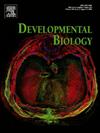Loss of KAT6B causes premature ossification and promotes osteoblast differentiation during development
IF 2.5
3区 生物学
Q2 DEVELOPMENTAL BIOLOGY
引用次数: 0
Abstract
The MYST family histone acetyltransferase gene, KAT6B (MYST4, MORF, QKF) is mutated in two distinct human congenital disorders characterised by intellectual disability, facial dysmorphogenesis and skeletal abnormalities; the Say-Barber-Biesecker-Young-Simpson variant of Ohdo syndrome and Genitopatellar syndrome. Despite its requirement in normal skeletal development, the cellular and transcriptional effects of KAT6B in skeletogenesis have not been thoroughly studied. Here, we show that germline deletion of the Kat6b gene in mice causes premature ossification in vivo, resulting in shortened craniofacial elements and increased bone density, as well as shortened tibias with an expanded pre-hypertrophic layer, as compared to wild type controls. Mechanistically, we show that the loss of KAT6B in mesenchymal progenitor cells promotes transition towards an osteoblast-progenitor state with upregulation of gene targets of RUNX2, a master regulator of osteoblast development and concomitant downregulation of SOX9, a critical gene in chondrocyte development. Moreover, we find that compound heterozygosity at Kat6b and Runx2 loci partially rescues the reduction in ossification of Runx2 heterozygous, but not homozygous mice, suggesting that KAT6B may limit the action of RUNX2, possibly through a role in maintaining progenitors in an undifferentiated state. Moreover, our results show that KAT6B has essential roles in regulating the expression of a large number of genes involved in skeletogenesis and bone development.

KAT6B缺失会导致过早骨化,并在发育过程中促进成骨细胞分化。
MYST家族组蛋白乙酰转移酶基因KAT6B (MYST4、MORF、QKF)在两种不同的人类先天性疾病中发生突变,其特征是智力残疾、面部畸形和骨骼异常;Say-Barber-Biesecker-Young-Simpson变异的Ohdo综合征和生殖器髌骨综合征。尽管正常骨骼发育需要KAT6B,但KAT6B在骨骼形成中的细胞和转录作用尚未得到深入研究。在这里,我们表明,与野生型对照相比,小鼠种系Kat6b基因的缺失会导致体内过早骨化,导致颅面元件缩短,骨密度增加,胫骨缩短,前肥厚层扩大。在机制上,我们发现间充质祖细胞中KAT6B的缺失通过上调RUNX2(成骨细胞发育的主要调控因子)的基因靶点,以及伴随的下调SOX9(软骨细胞发育的关键基因),促进向成骨祖细胞状态的转变。此外,我们发现Kat6b和Runx2位点的复合杂合性部分地挽救了Runx2杂合小鼠骨化的减少,而不是纯合小鼠,这表明Kat6b可能限制Runx2的作用,可能是通过维持祖细胞处于未分化状态的作用。此外,我们的研究结果表明,KAT6B在调节大量参与骨骼形成和骨骼发育的基因的表达中发挥重要作用。
本文章由计算机程序翻译,如有差异,请以英文原文为准。
求助全文
约1分钟内获得全文
求助全文
来源期刊

Developmental biology
生物-发育生物学
CiteScore
5.30
自引率
3.70%
发文量
182
审稿时长
1.5 months
期刊介绍:
Developmental Biology (DB) publishes original research on mechanisms of development, differentiation, and growth in animals and plants at the molecular, cellular, genetic and evolutionary levels. Areas of particular emphasis include transcriptional control mechanisms, embryonic patterning, cell-cell interactions, growth factors and signal transduction, and regulatory hierarchies in developing plants and animals.
 求助内容:
求助内容: 应助结果提醒方式:
应助结果提醒方式:


